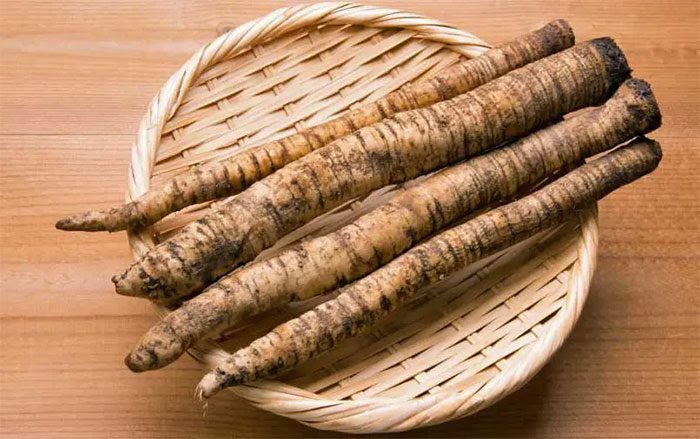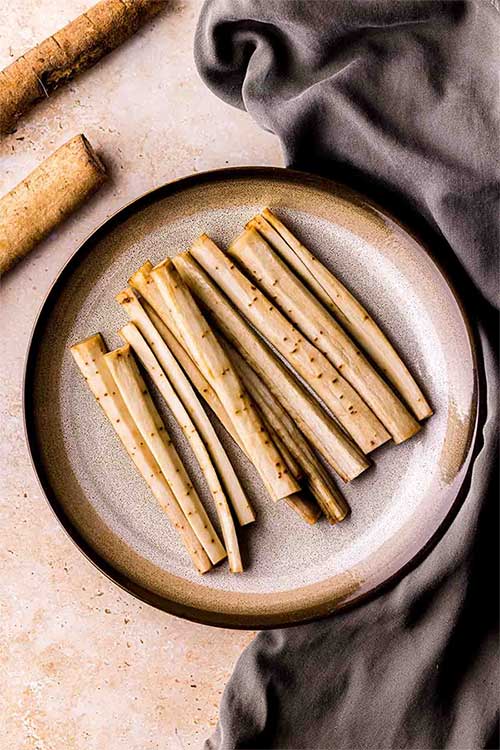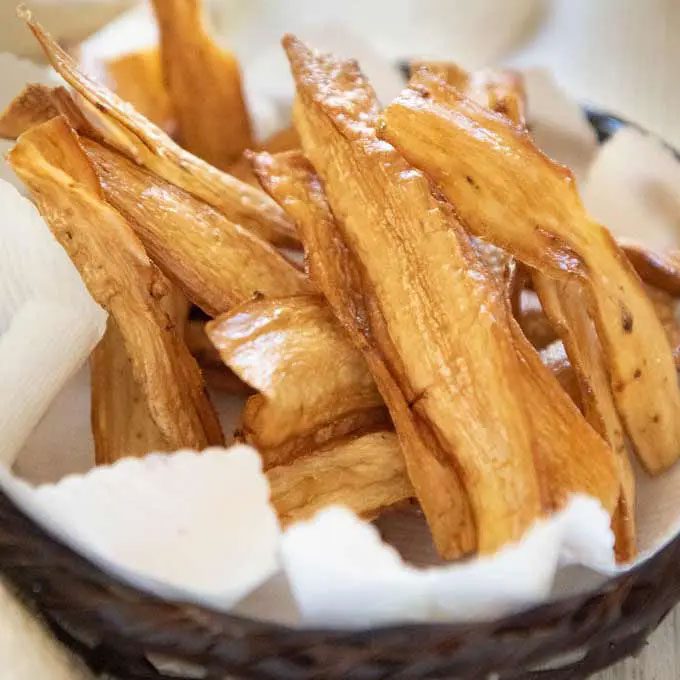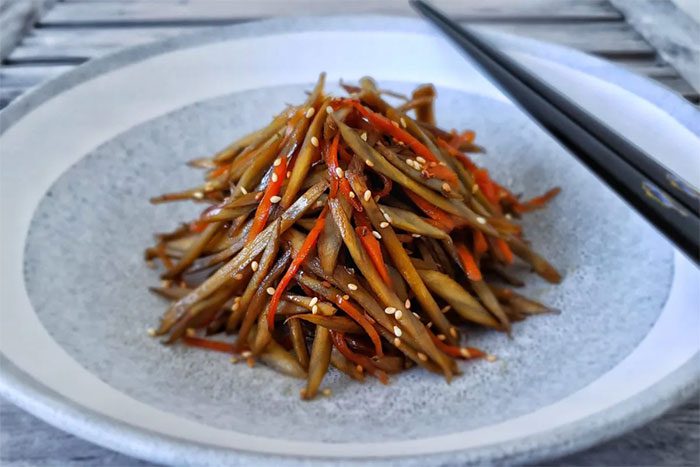Burdock root is a highly nutritious food that has been utilized in cuisine and medicine for hundreds of years. The effects of burdock root are often noted for its rich antioxidant properties, cardiovascular protection, and more…
Benefits of Burdock Root
Burdock root is rich in antioxidants and can be used as a natural remedy for various health conditions. It can be consumed as tea, powder, or extract, and incorporated into many dishes.
What is Burdock?
Burdock is a plant belonging to the Asteraceae family. It originates from Northern Asia and Europe but is cultivated in other parts of the world, including North America. Typically, burdock root is made into tea, which provides the most benefits, but the fruit and seeds can also be used medicinally.
1. Health Benefits of Burdock Root
While many uses of burdock root have been passed down through tradition, only a few have been supported by scientific research. Recently, researchers have discovered more potential uses and health benefits that burdock root offers. This may provide sufficient grounds for using burdock root as a supplementary treatment for certain health conditions.
Burdock root is particularly rich in inulin (making up 50% – 70%), prebiotic fiber, and other beneficial plant compounds such as flavonoids and phytochemicals, along with various antioxidants.

Burdock root has numerous health benefits. (Photo: Internet).
1.1. A Source of Powerful Antioxidants
Burdock root has been shown to contain a variety of potent antioxidants, including quercetin, luteolin, and phenolic acids.
These antioxidants protect cells in the body from damage caused by free radicals and help treat and prevent various underlying health conditions. Free radicals can lead to numerous diseases, including cancer, aging, and inflammatory disorders.
Antioxidants also help reduce inflammation. According to Healthline, burdock root has been shown to reduce inflammatory markers in the blood of patients with arthritis.
1.2. Detoxifies the Blood
According to Healthline, one of the most commonly cited uses of burdock root is for blood purification. Although there is very little Western scientific evidence to support this, in Traditional Chinese Medicine, burdock root has long been used for detoxifying the body or cleansing the blood.
Recent evidence has shown that burdock root contains active compounds that can help eliminate toxins from the blood while promoting blood circulation at the skin’s surface. This effect may be attributed to burdock’s ability to fight certain infections and bacteria. However, it is advisable to consult a doctor before using burdock root for blood purification.

Consult a doctor before using burdock root for blood purification. (Photo: Internet).
1.3. May Inhibit Certain Types of Cancer
According to Medical News Today, a 2016 study found that burdock could slow the growth of breast cancer tumors.
Free radicals and inflammation are both linked to cancer development. The antioxidant and anti-inflammatory properties of burdock root may be the mechanism behind this effect. Specifically, the flavonoids and polyphenols in burdock root may help slow tumor growth and alleviate pain from certain cancers. However, more research is needed to fully understand the effects of burdock on various types of cancer and tumors.
1.4. Treats Skin Issues
Burdock root has long been used to treat skin conditions such as acne, psoriasis, and eczema due to its anti-inflammatory and antibacterial properties when applied topically.

Many dishes can be prepared from burdock root. (Photo: Internet).
1.5. Improves Metabolic Syndrome
Metabolic syndrome is characterized by high blood pressure, elevated blood sugar and cholesterol levels, and increased abdominal fat.
According to Medical News Today, a 2014 study indicated that burdock root could help lower dangerously high blood sugar levels. Another small study involving older women with metabolic syndrome also suggested that tea made from burdock root could boost hormones and DHEA-S (dehydroepiandrosterone sulfate), helping to improve body composition and reduce symptoms of metabolic syndrome.
However, the scale of these studies is quite small and needs to be expanded with larger populations to confirm this benefit.
1.6. Can Burdock Root Treat Colds?
For centuries, burdock root has been used to treat the common cold, sore throat, and other infections due to its antibacterial properties and its effectiveness in destroying biofilms of large, sticky bacterial colonies.
Besides burdock root, burdock seeds (burdock fruit) are also a common remedy for treating sore throat, colds, fever, and cough with phlegm.
1.7. Diuretic Properties
Burdock root may also act as a diuretic, helping to eliminate water from the body and alleviating water retention in individuals with conditions that cause fluid retention or those taking medications that have water-retaining side effects.
2. Side Effects of Burdock Root
Burdock may cause allergic reactions and unwanted side effects, though these are quite rare and mostly limited to reported cases. For instance, a man in Japan reported experiencing shortness of breath and hives after consuming burdock root. A woman who drank detox tea made with burdock alongside other herbal ingredients for a month suffered from acute liver damage and stomach pain.

Burdock may cause some side effects. (Photo: Internet).
However, it is important to note that you should consult a doctor before use, and if you experience difficulty breathing, seek emergency assistance immediately.
You should avoid using burdock root if you are:
- Pregnant, planning to become pregnant, or breastfeeding
- Under 18 years of age
- Allergic to plants such as daisies, unless advised to use by a doctor
- Taking diuretics, diabetes medications, anticoagulants, cisplatin, quercetin, or tamoxifen.
Additionally, individuals with chronic or life-threatening health conditions should also consult a doctor before using burdock root.
3. Precautions When Using
- If you are taking supplements from burdock, only use them in moderation and as directed by your doctor.
- Burdock is considered safe to eat, but you should only purchase from reputable sellers rather than foraging in the wild, as some toxic plants resemble burdock, such as belladonna.
- Burdock root contains high levels of inulin, which may cause temporary bloating or gas after consumption. Symptoms may be more severe if you are sensitive to other inulin-rich foods.
Dosage: There is very little research and guidance on the recommended daily amount of burdock root. If you plan to use it as a supplement, consult a doctor first. Fresh burdock root should be peeled before eating; it can be consumed raw or cooked.
Burdock root can also be available in powder, tea, or fermented forms. One cup of burdock tea per day is considered safe.
Dishes made from burdock root include: kimbap, stir-fried burdock root, fermented burdock root, crispy fried burdock root, and more.
Overall, while many studies on the effects of burdock root and the plant itself exist, none have reached definitive conclusions, so it is not advisable to use it as a substitute for any prescribed medical treatment. Consult with a doctor to receive advice on the appropriate dosage for your health condition.



















































